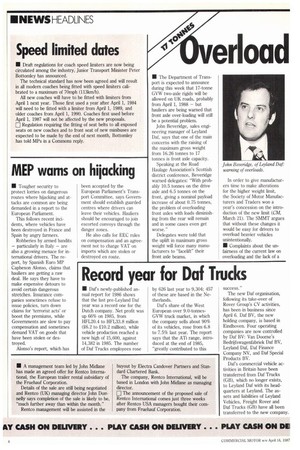erload fears weighed
Page 6

Page 7

If you've noticed an error in this article please click here to report it so we can fix it.
• The Department of Transport is expected to announce during this week that 17-tonne GVW two-axle rigids will be allowed on UK roads, probably from April 1, 1988 — but hauliers are being warned that front axle over-loading will still be a potential problem.
John Beveridge, sales engineering manager of Leyland Daf, says that one of the main concerns with the raising of the maximum gross weight from 16.26 tonnes to 17 tonnes is front axle capacity.
Speaking at the Road Ilaulage Association's Scottish district conference, Beveridge warned delegates: "With probably 10.5 tonnes on the drive axle and 6.5 tonnes on the front, giving a nominal payload increase of about 0.75 tonnes, the problem of overloading front axles with loads diminishing from the rear will remain and in some cases even get worse."
Delegates were told that the uplift in maximum gross weight will force many manufacturers to "facelift" their front axle beams. In order to give manufacturers time to make alterations for the higher weight limit, the Society of Motor Manufacturers and Traders won a year's concession on the introduction of the new limit (CM, March 21). The SMMT argues that without these changes it would be easy for drivers to overload heavier vehicles unintentionally.
• Complaints about the unfairness of the current law on overloading and the lack of a successful 'due diligence' plea were fired at senior Scottish lawyers at the RHA conference in Peebles.
Scottish area Licensing Authority Hugh McNamara, Lanark Procurator Fiscal Stewart Houston, Sheriff of Glasgow John McGuire and Lothian's assistant chief constable John Denham, all expressed sympathy with hauliers' problems on this issue, but despite being
pressed hard by Scottish RI-IA chairman Charles Rolph and RHA district manager Tom Brattin, none could offer any hope of an early change in the law.
"We are in a corner too, faced with an 'absolute offence'," said Houston. Brattin wanted to know why overloading offenders are now always charged with 'using' rather than with 'causing and permitting' which would, in effect, allow a defence of 'due diligence' to be made.
"The offence is one of using, with simultaneous liability for the driver and the operator," explained Houston. 'That is the law according to the Construction and Use Regulations. Since the Smith v McNab case in 1977, virtually all overloading charges in Scotland have related to using, because if the charge were 'causing and permitting' there would probably be no case to answer.'"
Several delegates complained of the shortage of suitable public weighbridges, the inaccuracies of dynamic axle weighing and the inability, or unwillingness, of many con
signors to help hauliers load their vehicles correctly.
Sheriff McGuire advised hauliers to consider getting tougher with their customers: "I wonder about the contractual relationship between you and the customers who may be responsible for your vehicles being overloaded. I would think it possible for a contract to be drafted which enabled you to recover overloading fine costs on a civil law basis," he said.




















































































